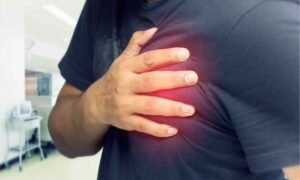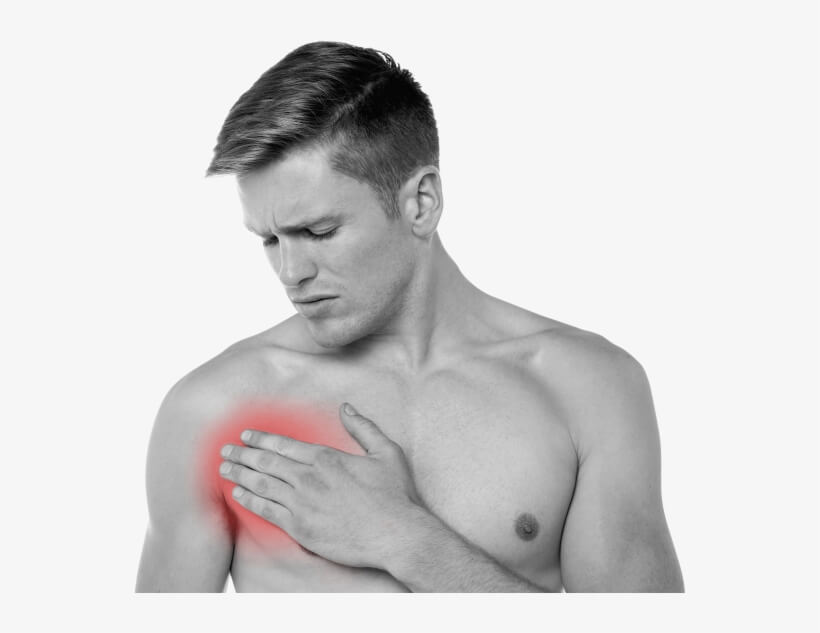It’s the middle of summer and you’re out playing ball with your friends. You go up for a rebound and suddenly feel a sharp pain in your chest. You’ve pulled a muscle! If this has happened to you, don’t worry, there are ways to help speed up the healing process. In this blog post, we will discuss some tips on how to tell if you’ve pulled a muscle in your chest and how to recover quickly.
Contents
What Does Pulled Muscle In Chest Mean?
 A pulled muscle in your chest is a common injury that can occur due to strenuous activity or overexertion. The most commonly affected muscle is the pectoralis major, which is the largest muscle in the chest. This muscle attaches at the front of the shoulder and extends down to the breastbone.
A pulled muscle in your chest is a common injury that can occur due to strenuous activity or overexertion. The most commonly affected muscle is the pectoralis major, which is the largest muscle in the chest. This muscle attaches at the front of the shoulder and extends down to the breastbone.
A pulled muscle in this area can be very painful and make it difficult to move your arm or breathe deeply. In some cases, the muscle may even tear partially or completely. This is simply described as a muscle strain that occurs when the muscle is overloaded and tears.
If you think you may have pulled a muscle in your chest, it’s important to seek medical attention right away. Your doctor will be able to properly diagnose your injury and recommend the best course of treatment.
How To Identify It?
It is not easy to find out that you have pulled a muscle in your chest as the pain is not localized and it can be difficult to point to the exact spot. The best way to identify whether you have pulled a muscle in your chest is by checking for tenderness and warmth in the area. You may also feel a sharp pain when you touch or press on the affected area.
In addition, there are a few common signs that can indicate that you have pulled a muscle in your chest. These include:
- Swelling in the affected area
- Bruising in the affected area
- Muscle spasms or cramping in the affected area
- Difficulty moving the arm on the affected side
These signs may not be present immediately after you injure your chest muscle. They may take a few hours or even days to develop. If you have any of these signs or symptoms, it’s important to see your doctor so they can rule out other possible causes, such as a heart attack. With the right intervention and care, you can expect to make a full recovery from a pulled chest muscle.
What Causes Pulled Muscle In Chest?
 There are many things that can cause you to pull a muscle in your chest. Some of the most common causes include:
There are many things that can cause you to pull a muscle in your chest. Some of the most common causes include:
- Overexertion during physical activity: It is possible to pull a muscle in your chest if you participate in strenuous activity or exercise without properly warming up your body first. This is especially true if you are not used to participating in this type of activity on a regular basis.
- Lifting something heavy: If you lift something heavy without using proper form, you may be more likely to pull a muscle in your chest.
- Sudden impact or trauma: A pulled muscle in your chest can also be caused by a sudden impact or trauma to the area, such as from a car accident.
- Falls: Sometimes, a fall can cause you to pull a muscle in your chest.
- Repeated motions: This is another common cause of pulled muscles. If you perform the same motion over and over again, such as typing on a keyboard or swinging a golf club, you may be more likely to pull a muscle.
In addition to these causes, there are some other risk factors that can increase your chance of pulling a muscle in your chest. These include:
- Age: As you get older, your muscles may become weaker and less able to handle the same amount of stress as they could when you were younger. This can make you more likely to pull a muscle.
- Obesity: If you are obese, you may be more likely to pull a muscle due to the extra strain that is placed on your muscles.
So these are a few of the things that can cause you to pull a muscle in your chest. If you think you may have pulled a muscle, it is important to seek medical attention right away so that you can get the proper diagnosis and treatment.
How Is It Diagnosed?
It is usually diagnosed based on your symptoms and a physical examination. Your doctor may order tests, such as:
- An X-ray or MRI, to rule out other causes of your pain, such as a broken bone.
- Other tests, such as electromyography (EMG), check for nerve damage.
A diagnosis is not an easy thing to come by when it comes to a pulled muscle in your chest. The best way to get an accurate diagnosis is by visiting your doctor and getting tests done. These tests work to rule out other potential causes of your pain, such as a broken bone.
Therefore, if you are experiencing pain in your chest that you think may be due to a pulled muscle, it is best to visit your doctor. They will be able to give you a more accurate diagnosis and help you get on the path to recovery. A pulled muscle in the chest can be a very painful and debilitating injury, so it is best to get it treated as soon as possible.
What Are The Treatment Options?
 There are a few options available when it comes to treating a pulled muscle in your chest. Some of the options are listed below:
There are a few options available when it comes to treating a pulled muscle in your chest. Some of the options are listed below:
Rest
It is one of the most important things that you can do when you have pulled a muscle in your chest. You need to give your body time to heal and the only way to do that is by resting. Try to avoid any strenuous activity or exercises that may aggravate the condition.
Ice
Applying ice to the affected area can help reduce swelling and pain. It is important to do this for the first 24-48 hours after the injury. For example, you can put ice in a plastic bag and wrap it in a thin towel. Apply this to the area for 20 minutes at a time, 4-8 times per day.
Heat
After the first 48 hours, you can switch to using heat to help soothe the muscle. Heat can help increase blood flow to the area, which can aid in the healing process. Use a heating pad or warm compress for 15-20 minutes at a time. It can be helpful to do this several times throughout the day.
Compression
Using a compression bandage can also help reduce swelling. It is important to not make the bandage too tight, as this can cause additional pain. This is about supporting the area, not constricting it. For example, an elastic bandage or wrap can be applied. If you’re not sure how to do this, ask your doctor or physical therapist for guidance.
Stretch
It is important to keep the muscles in your chest stretched and strong in order to avoid injury. There is a variety of stretching that you can do to maintain healthy muscles.
One stretch that can help prevent a pulled muscle in chest is the pec stretch. To do this stretch, stand with your arms at your sides and clasp your hands behind your back. Take a deep breath in and as you exhale, bend forward from the waist. Hold this stretch for 30 seconds.
Another stretch that can help is the door chest stretch. Start by standing in an open doorway with your arms at 90-degree angles, palms flat against the doorframe. Step forward with one foot and lean your body forward until you feel a stretch in the chest. Hold this stretch for 30 seconds and then repeat on the other side.
Strengthening exercises
 It is essential to keep the muscles in your chest strong and healthy. However, doing exercises that put a strain on your chest muscles can lead to a pulled muscle. To help prevent this, make sure to warm up before working out and start with lighter weights. As your muscles get stronger, you can slowly increase the intensity of your workouts. These are some of the best exercises to strengthen your chest muscles:
It is essential to keep the muscles in your chest strong and healthy. However, doing exercises that put a strain on your chest muscles can lead to a pulled muscle. To help prevent this, make sure to warm up before working out and start with lighter weights. As your muscles get stronger, you can slowly increase the intensity of your workouts. These are some of the best exercises to strengthen your chest muscles:
- Push-ups
- Chest press
- Flyes
- Pull-ups
- Chin-ups
- Lat pull-downs
Consider medication
If you are in pain, you may want to take over-the-counter pain relievers such as ibuprofen (Advil) or acetaminophen (Tylenol). It works best if you take the medication at the first sign of pain. It is believed that medication works by reducing inflammation. For example, it is thought that acetaminophen works by inhibiting the production of prostaglandins, which are hormones that play a role in inflammation.
These are some above-discussed treatment options that can help you get relief from the pain of a pulled muscle in your chest. But, it is always best to prevent the injury in the first place. We will discuss some prevention tips for you further!
How Can You Prevent Pulled Muscle In Chest?
A pulled muscle in the chest may be caused by several things such as bad posture, incorrect form while working out, and even sleeping in an awkward position. There are a few ways you can prevent this from happening:
- Warm up before any type of physical activity
- Use proper form when working out, especially when lifting weights
- Stretch regularly
- Maintain good posture
- Avoid sleeping in positions that put a strain on the chest muscles
These things are believed to help prevent a pulled muscle in the chest. Because the chest is such a large and used muscle group, it is more susceptible to injury. According to studies, when you warm up before any type of physical activity, your muscles are better prepared for the work ahead and are less likely to be injured.
Therefore, it is important to prevent a pulled muscle in the chest by using proper form when working out and stretching regularly. With the right care, you can avoid this type of injury and keep your chest muscles healthy.
Conclusion
In conclusion, pulled muscle in chest is often difficult to diagnose because the symptoms may closely resemble other conditions. However, if you experience sudden, sharp pain in your chest that gets worse with activity, it’s likely that you’ve pulled a muscle. Rest and ice are typically the best treatments for a pulled muscle, but you may also need to take anti-inflammatory medication or see a physical therapist for recovery.
Physical Therapy help patients recover from pain. If you’re experiencing Back pain, Shoulder pain, Knee pain, Neck pain, Elbow pain, Hip pain, or Arthritis pain, a physical therapist at MantraCare can help: Book a physiotherapy session.


